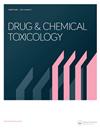Exploring the toxicity profile of coriander (C. sativum L.) essential oil: implications for translational toxicological research.
IF 2.1
4区 医学
Q3 CHEMISTRY, MULTIDISCIPLINARY
引用次数: 0
Abstract
The plant species C. sativum L. is a staple in cuisine and holds significant ethnopharmacological value. Its essential oil (EO) is of particular interest, yet its toxicity profile remains a subject of inquiry. This study aimed to elucidate the chemical constituents of C. sativum L. EO and evaluate its toxicity through various parameters, including cytotoxicity assays on HaCaT keratinocytes, in vivo toxicity tests on Galleria mellonella larvae, in vivo genotoxicity assessments on mice and cytotoxicity assays on human erythrocytes. Notably, major constituents such as 2-decen-1-ol, dec-(2E)-enal, and 1,6-octadien-3-ol were found to remain predominant. The IC50 value for the essential oil on the keratinocyte cell line was determined to be 60.13 ± 2.02 µg/mL. However, in vivo toxicity tests with G. mellonella larvae demonstrated safety at doses below 4.5 g/kg. Additionally, genotoxicity assessment revealed that a single dose of 20 mg/mL (5 mg/kg) did not induce a significant increase in micronuclei formation. EO concentrations above 250 µg/mL led to significant changes in human erythrocytes cell viability (p < 0.0001), resulting in over 60% hemolysis. These findings collectively suggest that the essential oil of C. sativum L. exhibits a suitable toxicity profile for conducting preclinical studies in vertebrate animal models.探索芫荽(C. sativum L.)精油的毒性特征:对转化毒理学研究的影响。
C. sativum L. 是一种主食植物,具有重要的民族药理学价值。它的精油(EO)尤其引人关注,但其毒性特征仍是一个研究课题。本研究旨在阐明 C. sativum L. 精油的化学成分,并通过各种参数评估其毒性,包括对 HaCaT 角质细胞的细胞毒性试验、对 Galleria mellonella 幼虫的体内毒性试验、对小鼠的体内遗传毒性评估以及对人类红细胞的细胞毒性试验。值得注意的是,2-癸烯-1-醇、癸-(2E)-烯醛和 1,6-辛二烯-3-醇等主要成分仍占主导地位。精油对角质细胞系的 IC50 值为 60.13 ± 2.02 µg/mL。不过,用 G. mellonella 幼虫进行的体内毒性测试表明,剂量低于 4.5 克/千克时是安全的。此外,遗传毒性评估显示,单剂量 20 毫克/毫升(5 毫克/千克)不会诱发微核形成的显著增加。250 µg/mL 以上的环氧乙烷浓度会导致人类红细胞的活力发生显著变化(p < 0.0001),造成 60% 以上的溶血。这些发现共同表明,荠菜精油具有适合在脊椎动物模型中进行临床前研究的毒性特征。
本文章由计算机程序翻译,如有差异,请以英文原文为准。
求助全文
约1分钟内获得全文
求助全文
来源期刊

Drug and Chemical Toxicology
医学-毒理学
CiteScore
6.00
自引率
3.80%
发文量
99
审稿时长
3 months
期刊介绍:
Drug and Chemical Toxicology publishes full-length research papers, review articles and short communications that encompass a broad spectrum of toxicological data surrounding risk assessment and harmful exposure. Manuscripts are considered according to their relevance to the journal.
Topics include both descriptive and mechanics research that illustrates the risk assessment implications of exposure to toxic agents. Examples of suitable topics include toxicological studies, which are structural examinations on the effects of dose, metabolism, and statistical or mechanism-based approaches to risk assessment. New findings and methods, along with safety evaluations, are also acceptable. Special issues may be reserved to publish symposium summaries, reviews in toxicology, and overviews of the practical interpretation and application of toxicological data.
 求助内容:
求助内容: 应助结果提醒方式:
应助结果提醒方式:


